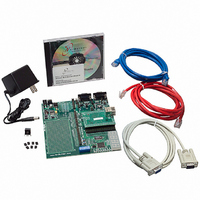NNDK-MOD5272-KIT NetBurner Inc, NNDK-MOD5272-KIT Datasheet - Page 115

NNDK-MOD5272-KIT
Manufacturer Part Number
NNDK-MOD5272-KIT
Description
KIT DEVELOP NETWORK FOR MOD5272
Manufacturer
NetBurner Inc
Series
ColdFire®r
Datasheets
1.MOD5272-100IR.pdf
(2 pages)
2.MOD5272-100IR.pdf
(550 pages)
3.NNDK-MOD5282-KIT.pdf
(2 pages)
Specifications of NNDK-MOD5272-KIT
Main Purpose
*
Embedded
*
Utilized Ic / Part
MOD5272
Primary Attributes
*
Secondary Attributes
*
Processor To Be Evaluated
MOD5272
Interface Type
RS-232, RS-485, USB
Lead Free Status / RoHS Status
Contains lead / RoHS non-compliant
Lead Free Status / RoHS Status
Lead free / RoHS Compliant, Contains lead / RoHS non-compliant
Other names
528-1001
- Current page: 115 of 550
- Download datasheet (6Mb)
MOTOROLA
4.5.2 Instruction Cache Operation
The instruction cache is physically connected to the ColdFire core's local bus, allowing it
to service all instruction fetches from the ColdFire core and certain memory fetches
initiated by the debug module. Typically, the debug module's memory references appear as
supervisor data accesses but the unit can be programmed to generate user-mode accesses
and/or instruction fetches. The instruction cache processes any instruction fetch access in
the normal manner.
4.5.2.1 Interaction with Other Modules
Because both the instruction cache and high-speed SRAM module are connected to the
ColdFire core's local data bus, certain user-defined configurations can result in
simultaneous instruction fetch processing.
If the referenced address is mapped into the SRAM module, that module services the
request in a single cycle. In this case, data accessed from the instruction cache is discarded
without generating external memory references. If the address is not mapped into SRAM
space, the instruction cache handles the request in the normal fashion.
4.5.2.2 Cache Coherency and Invalidation
The instruction cache does not monitor ColdFire core data references for accesses to cached
instructions. Therefore, software must maintain cache coherency by invalidating the
appropriate cache entries after modifying code segments.
Cache invalidation can be performed in the two following ways:
These invalidation operations can be initiated from the ColdFire core or the debug module.
4.5.2.3 Caching Modes
For every memory reference generated by the processor or debug module, a set of effective
attributes is determined based on the address and the ACRs. Caching modes determine how
the cache handles an access. An access can be cacheable or cache-inhibited. For normal
accesses, the ACRn[CM] bit corresponding to the address of the access specifies the
caching mode. If an address does not match an ACR, the default caching mode is defined
by CACR[DCM]. The specific algorithm is as follows:
• Setting CACR[CINVA] forces the entire instruction cache to be marked as invalid.
• The privileged CPUSHL instruction can invalidate a single cache line. When this
The invalidation operation requires 64 cycles because the cache sequences through
the entire tag array, clearing a single location each cycle. Any subsequent instruction
fetch accesses are postponed until the invalidation sequence is complete.
instruction is executed, the cache entry defined by bits 9–4 of the source address
register is invalidated, provided CACR[CDPI] is cleared.
Chapter 4. Local Memory
Instruction Cache Overview
4-9
Related parts for NNDK-MOD5272-KIT
Image
Part Number
Description
Manufacturer
Datasheet
Request
R

Part Number:
Description:
BOARD SERIAL-ETHERNET 512K FLASH
Manufacturer:
NetBurner Inc
Datasheet:

Part Number:
Description:
PROCESSOR MODULE FLASH MOD5272
Manufacturer:
NetBurner Inc
Datasheet:

Part Number:
Description:
PROCESSOR MODULE 512KB FLASH
Manufacturer:
NetBurner Inc
Datasheet:

Part Number:
Description:
DUAL PORT SERIAL-ETHERNET
Manufacturer:
NetBurner Inc
Datasheet:

Part Number:
Description:
PROCESSOR MODULE FLASH
Manufacturer:
NetBurner Inc
Datasheet:

Part Number:
Description:
PROCESSOR MODULE 512KB FLASH
Manufacturer:
NetBurner Inc
Datasheet:

Part Number:
Description:
MOD5234 10/100 ETHERNET MODULE
Manufacturer:
NetBurner Inc
Datasheet:

Part Number:
Description:
KIT DEVELOP NETWORK FOR MOD5282
Manufacturer:
NetBurner Inc
Datasheet:

Part Number:
Description:
DUAL PORT SERIAL-ETHERNET
Manufacturer:
NetBurner Inc
Datasheet:

Part Number:
Description:
Ethernet Modules & Development Tools 32 Bit 66MHz 40 Pin DIP Industrial Temp
Manufacturer:
NetBurner Inc
Datasheet:

Part Number:
Description:
Ethernet Modules & Development Tools MOD5213 DEVELOPMENT KIT
Manufacturer:
NetBurner Inc

Part Number:
Description:
Ethernet Modules & Development Tools DUAL PORT SERIAL EHTERNET DEVICE
Manufacturer:
NetBurner Inc
Datasheet:

Part Number:
Description:
Ethernet ICs 32bit 147MHz CAN-to- Ethnt Device IndTemp
Manufacturer:
NetBurner Inc
Datasheet:










